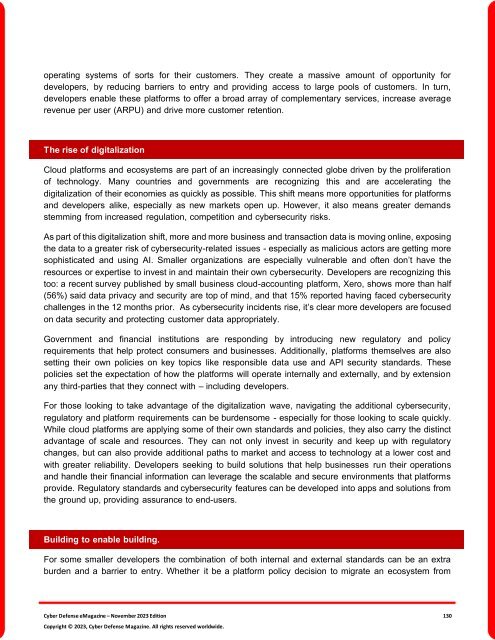The Cyber Defense eMagazine November Edition for 2023
Cyber Defense eMagazine November Edition for 2023 #CDM #CYBERDEFENSEMAG @CyberDefenseMag by @Miliefsky a world-renowned cyber security expert and the Publisher of Cyber Defense Magazine as part of the Cyber Defense Media Group as well as Yan Ross, Editor-in-Chief and many more writers, partners and supporters who make this an awesome publication! 196 page November Edition fully packed with some of our best content. Thank you all and to our readers! OSINT ROCKS! #CDM #CDMG #OSINT #CYBERSECURITY #INFOSEC #BEST #PRACTICES #TIPS #TECHNIQUES
Cyber Defense eMagazine November Edition for 2023 #CDM #CYBERDEFENSEMAG @CyberDefenseMag by @Miliefsky a world-renowned cyber security expert and the Publisher of Cyber Defense Magazine as part of the Cyber Defense Media Group as well as Yan Ross, Editor-in-Chief and many more writers, partners and supporters who make this an awesome publication! 196 page November Edition fully packed with some of our best content. Thank you all and to our readers! OSINT ROCKS! #CDM #CDMG #OSINT #CYBERSECURITY #INFOSEC #BEST #PRACTICES #TIPS #TECHNIQUES
You also want an ePaper? Increase the reach of your titles
YUMPU automatically turns print PDFs into web optimized ePapers that Google loves.
operating systems of sorts <strong>for</strong> their customers. <strong>The</strong>y create a massive amount of opportunity <strong>for</strong><br />
developers, by reducing barriers to entry and providing access to large pools of customers. In turn,<br />
developers enable these plat<strong>for</strong>ms to offer a broad array of complementary services, increase average<br />
revenue per user (ARPU) and drive more customer retention.<br />
<strong>The</strong> rise of digitalization<br />
Cloud plat<strong>for</strong>ms and ecosystems are part of an increasingly connected globe driven by the proliferation<br />
of technology. Many countries and governments are recognizing this and are accelerating the<br />
digitalization of their economies as quickly as possible. This shift means more opportunities <strong>for</strong> plat<strong>for</strong>ms<br />
and developers alike, especially as new markets open up. However, it also means greater demands<br />
stemming from increased regulation, competition and cybersecurity risks.<br />
As part of this digitalization shift, more and more business and transaction data is moving online, exposing<br />
the data to a greater risk of cybersecurity-related issues - especially as malicious actors are getting more<br />
sophisticated and using AI. Smaller organizations are especially vulnerable and often don’t have the<br />
resources or expertise to invest in and maintain their own cybersecurity. Developers are recognizing this<br />
too: a recent survey published by small business cloud-accounting plat<strong>for</strong>m, Xero, shows more than half<br />
(56%) said data privacy and security are top of mind, and that 15% reported having faced cybersecurity<br />
challenges in the 12 months prior. As cybersecurity incidents rise, it’s clear more developers are focused<br />
on data security and protecting customer data appropriately.<br />
Government and financial institutions are responding by introducing new regulatory and policy<br />
requirements that help protect consumers and businesses. Additionally, plat<strong>for</strong>ms themselves are also<br />
setting their own policies on key topics like responsible data use and API security standards. <strong>The</strong>se<br />
policies set the expectation of how the plat<strong>for</strong>ms will operate internally and externally, and by extension<br />
any third-parties that they connect with – including developers.<br />
For those looking to take advantage of the digitalization wave, navigating the additional cybersecurity,<br />
regulatory and plat<strong>for</strong>m requirements can be burdensome - especially <strong>for</strong> those looking to scale quickly.<br />
While cloud plat<strong>for</strong>ms are applying some of their own standards and policies, they also carry the distinct<br />
advantage of scale and resources. <strong>The</strong>y can not only invest in security and keep up with regulatory<br />
changes, but can also provide additional paths to market and access to technology at a lower cost and<br />
with greater reliability. Developers seeking to build solutions that help businesses run their operations<br />
and handle their financial in<strong>for</strong>mation can leverage the scalable and secure environments that plat<strong>for</strong>ms<br />
provide. Regulatory standards and cybersecurity features can be developed into apps and solutions from<br />
the ground up, providing assurance to end-users.<br />
Building to enable building.<br />
For some smaller developers the combination of both internal and external standards can be an extra<br />
burden and a barrier to entry. Whether it be a plat<strong>for</strong>m policy decision to migrate an ecosystem from<br />
<strong>Cyber</strong> <strong>Defense</strong> <strong>eMagazine</strong> – <strong>November</strong> <strong>2023</strong> <strong>Edition</strong> 130<br />
Copyright © <strong>2023</strong>, <strong>Cyber</strong> <strong>Defense</strong> Magazine. All rights reserved worldwide.

















